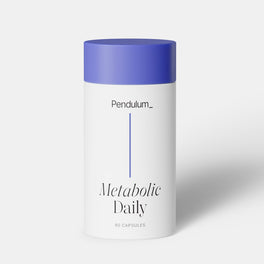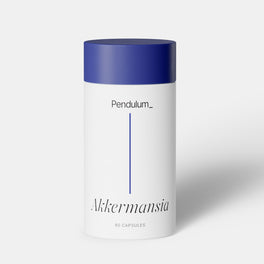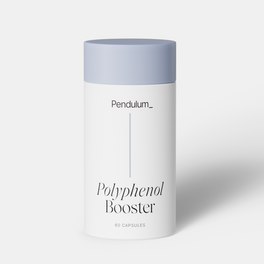Looks like your
cart is empty

Metabolic Daily
Improve metabolism

Akkermansia
Improves gut health

Polyphenol Booster
Increase antioxidants to protect cells
Stay in touch about special discounts, nutrition tips and additional education.
Looks like your
cart is empty

Improve metabolism

Improves gut health

Increase antioxidants to protect cells
Among the health-and-wellness community, there pretty much is a universal consensus that plant-based foods are good for you.
Plant-based foods are a health-and-wellness staple because they:
In addition to the aforementioned, some plant-based foods can boast about being high in “compounds” which give them their nutritional muscle.
Polyphenols are one of those compounds.
This article will answer the following questions:
Polyphenols—also known as phytonutrients—are behind the colors of the fruits and vegetable rainbow you are encouraged to eat.
Polyphenols are also a crucial component of the gut-microbiome diet.
Polyphenols are a category of chemicals that naturally occur in plants. They are commonly found in many fruits, vegetables, spices, cereals, nuts, and—in some cases—beverages and treats (see “What foods are high in polyphenols?” below)
There are more than 500 unique polyphenols. Collectively, these chemicals are known as “phytochemicals.”
Polyphenols can be further categorized into the following groups:
Researchers say adequate intake of polyphenols could confer health benefits.3
At present, it is difficult to recommend what “doses” of specific polyphenols you should consume to derive maximum benefit.4
Emeran Mayer, MD, a gastroenterologist, and professor in the Departments of Medicine, Physiology, and Psychiatry at the David Geffen School of Medicine at UCLA, is a pioneer of medical research into brain-gut interactions.
In an interview with Pendulum, Dr. Mayer said that a healthy diet is at the top of the priorities list when it comes to gut-microbiome health.
“Discussions about the ‘right diet’ have focused on how much protein, sugar, or fat is good for you, which is all not terribly relevant for the gut microbes,” says Dr. Mayer. “What is relevant, however, is these microbiota-targeted components of food—such as fiber, microbiota accessible carbohydrates (MACs), and polyphenols.”
The absorption and metabolism of polyphenol compounds have been well described and—for many— the gut microbiome plays a critical role in absorption.5
The gut microbiome is the intestinal community of microorganisms (bacteria, fungi, viruses) that play a pivotal role in your body maintaining internal, physical, and chemical balance.
Multiple factors, however, could interfere with this delicate gut-microbiome balance, including:
Dysbiosis occurs when your gut-bacteria community becomes imbalanced and has been associated with metabolic and gastrointestinal diseases.
In addition to having prebiotic properties and promoting a healthy immune system, polyphenols have also been shown to have a major impact on restoring the balance of “beneficial” gut bacteria within the gut microbiome.7
In early 2021, Polish researchers said that the therapeutic effects of polyphenols are “seriously compromised by the low bioavailability.”
Bioavailability is the extent to which absorption occurs in the body.8
The Polish researchers wrote, “In order to improve the bioavailability of the extracted polyphenols, it would be advantageous to use appropriate technological processes, for example, micro- and nanoencapsulation, or fermentation.”
Marion LeClerc, PhD, who is a Principal Scientist at Pendulum, says that this is a key point.
“Most of the polyphenols become bioavailable because they are metabolized by the gut microbiome,” says Dr. LeClerc. “Polyphenols need to be subject to microbial fermentation.”

At present, data around polyphenols supporting the growth of beneficial gut bacteria is in its infancy.
Dr, LeClerc points out that Pendulum scientists are looking how the 5 probiotic strains contained within Pendulum Glucose Control (e.g. Akkermansia muciniphila; bifidobacterium infantis, clostridium butyricum; Anaerobutyricum hallii; and Clostridium beijerinckii) are affected by the following 5 polyphenols:
Kristen Neusel, MS, RDN, LD, CDCES, NASM-CPT, says there are over 8,000 different polyphenols, which can make it difficult to determine which will be best for what outcome.
Neusel adds that evidence about polyphenols increasing Akkermansia muciniphila is inconsistent. What is known is that evidence exists showing that:
Dr. LeClerc says Pendulum scientists thinks Akkermansia muciniphila has the capacity to metabolize some polyphenols, and be part of the beneficial effects attributable to polyphenols.
“In mice, we see Akkermansia muciniphila increasing when the mice are being fed polyphenols,” says Dr. LeClerc. “We are confident that eating those beneficial polyphenols as part of the diet would increase Akkermansia muciniphila in most people.

If you are reading this on your phone and standing near the produce section of a grocery store, here are some polyphenol-rich foods to look for:12
Fruits that are high in polyphenols
Berries that are high in polyphenols
Vegetables that are high in polyphenols
Whole grains that are high in polyphenols
Nuts, seeds, and legumes that are high in polyphenols
Beverages that are high in polyphenols
Fats that are high in polyphenols
Spices and seasonings that are high in polyphenols
Polyphenols are chemically unstable molecules and their consumption and dietary requirements are difficult to predict.
Therefore, methods for extracting and producing polyphenol supplements have been enthusiastically proposed.13
New dietary supplements and polyphenol-rich foods for public consumption have been developed with the goal of:
When looking for gut-health resources, always look for credentialed, qualified sites that have registered dietitians or qualified credentialed healthcare providers providing sound, scientific advice.
For more information about Pendulum and its products, go to Pendulumlife.com.
Also, be sure to follow Pendulum on social media at:
LinkedIn
Facebook
Instagram
Twitter
TikTok
1. https://brainmd.com/blog/what-are-polyphenols/
2. https://brainmd.com/blog/what-are-polyphenols/
3. https://pubs.rsc.org/en/content/articlelanding/2019/FO/C8FO01997E
4. https://onlinelibrary.wiley.com/doi/10.1111/nbu.12278
5. https://onlinelibrary.wiley.com/doi/10.1111/nbu.12278
6. https://www.mdpi.com/1422-0067/22/7/3715
7. https://www.mdpi.com/2072-6643/11/9/2216
8. https://www.mdpi.com/1422-0067/22/7/3715/htm
9. https://www.sciencedirect.com/science/article/abs/pii/S0955286315002284?via%3Dihub
11. https://gut.bmj.com/content/64/6/872
12. https://www.medicalnewstoday.com/articles/319728#list-of-foods-that-are-high-in-polyphenolls
13. https://www.sciencedirect.com/science/article/pii/B9780123984562000074